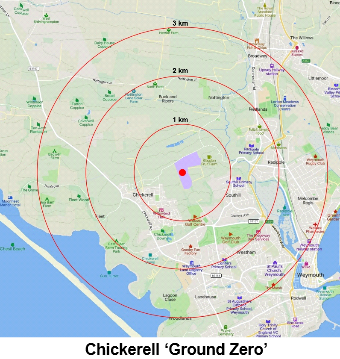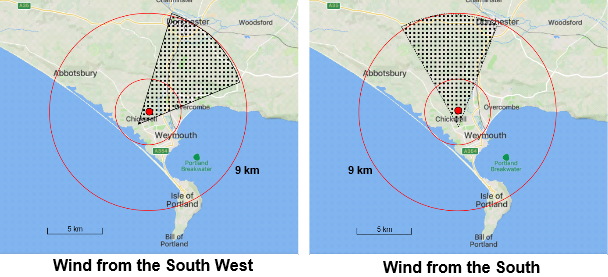
BESS INCIDENTS AND LOCAL LOCKDOWN
While examples of battery fires have been given earlier, it is useful to consider the recent incidents at Moss Landing California, and at Moorabool in Victoria which question the wisdom of a battery energy storage facility close to residential areas.
The Effect of a Moss Landing Incident on South Dorset

For the second Moss Landing the fire fighters battled to extinguish the fire and the 'Shelter in place was' advised for at least 14 hours. A similar emergency occurring in South Dorset could cause major disruption in Weymouth. A zone of 3km distance from the site of the BESS would encompass all of Chickerell, a large part of Weymouth, and surrounding farmland to the north and north-west. The map of Weymouth and Chickerell shows circles at 1km, 2km, and 3 km from the site of the BESS.
How quickly could farmers get their animals indoors? The many tourists and people going about their business in outdoor work would be suddenly vulnerable. Weymouth almost doubles its population in the tourist season with outdoors activities such as equitation, many camp sites, and crowded clean beaches.
Shoppers in Weymouth and Chickerell would be confined in shops and supermarkets, children in schools all seeking shelter. It would be a lockdown all over again but without preparation or warning.
Effect of a Moorabool Incident on South Dorset
For Moorabool the fire fighters decided to concentrate on saving adjacent battery containers and let the fire burn out. The decision of the Country Fire Authority in Australia to let the fire burn itself out while keeping it from spreading to other containers is an alternative option to fighting the centre of the fire itself with the real possibility of death or serious injury to the fire fighters from toxic fumes or explosions.
However this created a toxic plume travelling in a SW direction and it was clear that there was an area of potential toxicity which threatened the public. The fire burned itself out after 3½ days. If the wind direction had changed direction during this time presumably the area of potential toxicity would have been extended.
The Moorabool incident gives some idea of the shape of area of potential toxicity under a prevailing wind. The shape chosen approximates to a sector of angle about 50°, (covering an area slightly less than the Moorabool incident) and with the apex stepped back from the source of the fire. It is instructive to consider the areas threatened by toxic smoke if there were a container fire at a BESS at Chickerell and the fire fighters had to let the fire burn itself out. The diagrams below show the areas of potential toxicity depending on the wind direction, the outer red circle is 9 km from the site of the BESS (the red dot) while the inner circle is at 3km.
The wind blowing from the south west or from the south would tend to blow the smoke towards Dorchester. The hills north of Weymouth (Bayard Hill and Bincombe Hill) will force the plume to rise and adiabatic cooling would ensue with the possibility of rain. That rain could contain hydrofluoric acid - as Bob Dylan once sang 'A hard rain is gonna fall!'

The wind blowing from the North or North West could threaten parts of Portland Island. Either way, those unfortunate to reside within the area of potential toxicity would have to endure lockdown for many hours, perhaps days. If the fire occurred during a period of high pressure, the toxic smoke would not disperse in a particular direction but spread out over a wide area on Chickerell and Weymouth. (You can observe the effect if you light a garden fire at a time of high pressure area - the smoke just spreads out over neighbours gardens and the telephone begins to ring.)